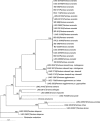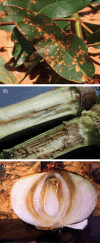Pantoea ananatis: an unconventional plant pathogen
- PMID: 19400836
- PMCID: PMC6640510
- DOI: 10.1111/j.1364-3703.2009.00542.x
Pantoea ananatis: an unconventional plant pathogen
Abstract
Pantoea ananatis causes disease symptoms in a wide range of economically important agricultural crops and forest tree species worldwide. It is regarded as an emerging pathogen based on the increasing number of reports of diseases occurring on previously unrecorded hosts in different parts of the world. Its unconventional nature lies in the fact that, unlike the majority of plant pathogenic microbes, P. ananatis is capable of infecting humans and occurs in diverse ecological niches, such as part of a bacterial community contaminating aviation jet fuel tanks and contributing to growth promotion in potato and pepper.
Taxonomy: Bacteria; Gammaproteobacteria; family Enterobacteriaceae; genus Pantoea.
Microbiological properties: Gram-negative; facultatively anaerobic; most strains are motile and produce a yellow pigment in culture; indole positive. BIOLOGY: Pantoea ananatis is a common epiphyte; it also occurs endophytically in hosts where it has been reported to cause disease symptoms and in hosts where no such symptoms have been described. Some strains are ice-nucleating, a feature which has been used as a biological control mechanism against some insect pests of agricultural crops and by the food industry.
Disease symptoms: Pantoea ananatis infects both monocotyledonous and dicotyledonous plants. The symptoms are diverse depending on the host infected, and include leaf blotches and spots, die-back, and stalk, fruit and bulb rot. BIOLOGICAL CONTROL AGENT: Pantoea ananatis has both antifungal and antibacterial properties. These characteristics have the potential of being exploited by biological control specialists.
Figures


References
-
- Abe, K. , Watabe, S. , Emori, Y. , Watanabe, M. and Arai, S. (1989) An ice nucleation active gene of Erwinia ananas. Sequence similarity to those of Pseudomonas species and regions required for ice nucleation activity. FEBS Lett. 258, 297–300. - PubMed
-
- Anderson, P.K. , Cunningham, A.A. , Patel, N.G. , Morales, F.J. , Epstein, P.R. and Daszak, P. (2004) Emerging infectious diseases of plants: pathogen pollution, climate change and agrotechnology drivers. Trends Ecol. Evol. 19, 535–544. - PubMed
-
- Azad, H.R. , Holmes, G.J. and Cooksey, D.A. (2000) A new leaf blotch disease of sudangrass caused by Pantoea ananas and Pantoea stewartii . Plant Dis. 84, 973–979. - PubMed
-
- Azegami, K. , Ozaki, K. and Matsuda, A. (1983) Bacterial palea browning, a new disease of rice caused by Erwinia herbicola . Bull. Nat. Inst. Agric. Sci. Ser. C 39, 1–12.
-
- Bandyopadhyay, R. and Frederiksen, R.A. (1999) Contemporary global movement of emerging pathogens. Ann. NY Acad. Sci. 894, 28–36. - PubMed
Publication types
MeSH terms
LinkOut - more resources
Full Text Sources
Other Literature Sources

